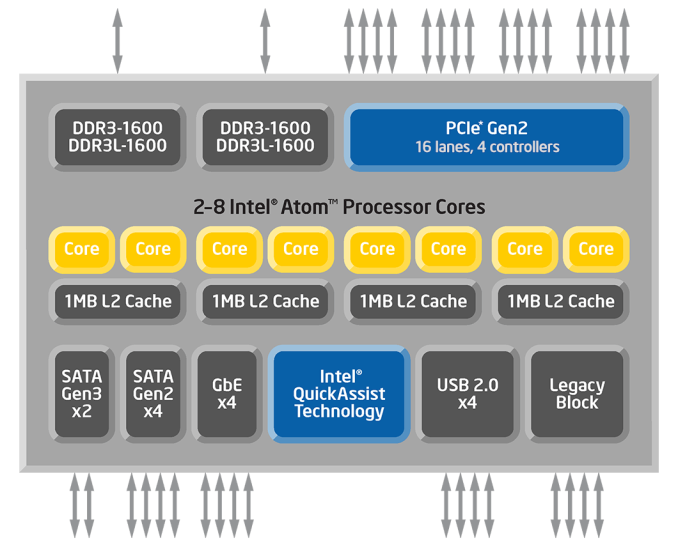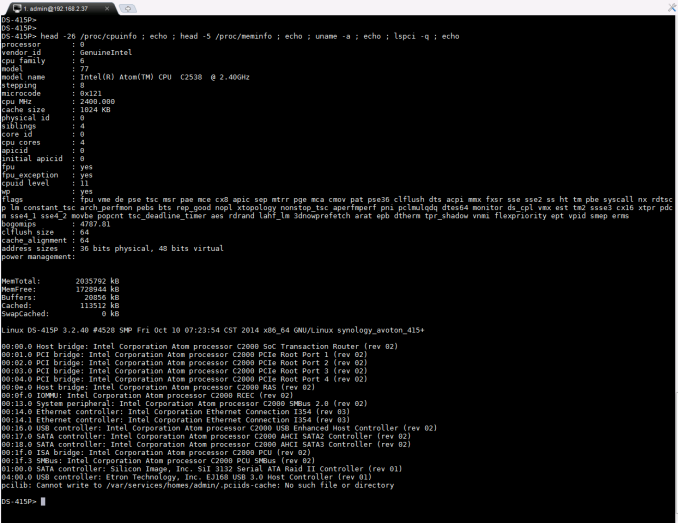Synology DS415+ Review: DSM on Intel Rangeley
by Ganesh T S on October 30, 2014 7:30 AM EST- Posted in
- NAS
- Storage
- Intel
- Synology
- Silvermont
- Enterprise
- Rangeley
Platform Analysis
The higher end segment of the SOHO / SMB NAS market uses Intel's Core-series and Xeon CPUs to deliver the required performance while supporting a large number of drive bays (typically more than 8, in a rackmount form-factor). Over the last four years or so, Intel's play in the other tiers has been mainly with its Atom CPU lineup. Back in 2010, Intel pushed the 45 nm Atom D410 / D510 / D525 for NAS units. In 2012, it was the 32 nm Atoms, the D2550 and D2700. All of these were based on the in-order Bonnell microarchitecture which was fast becoming dated compared to the advancements being made by the ARM SoC vendors. In moving from 32nm to 22nm, Intel completely revamped the microarchitecture for their Atom cores. Bonnell was replaced by Silvermont, bringing out of order execution and other improvements into the picture. Silvermont's applicability to a variety of power profiles meant that there were multiple product lines that ended up using the CPU cores. Bay Trail is proving very effective in tablets and also makes up QNAP's TS-x51 and TS-x53 Pro NAS series. Merrifield and Moorefield are trying to break into smartphones, but it is Avoton and Rangeley that are more relevant to the storage appliances market.
The different product lines integrated different I/O around the Silvermont cores depending on the target market. Avoton is meant for microservers and cloud storage platforms, while Rangeley is meant for communication and network infrastructure. Both of them integrate similar I/O around the cores, but the Rangeley parts have an updated crypto engine. The block diagram of a generic Rangeley part is provided below.
There is a wealth of I/O (2x SATA Gen 3, 4x SATA Gen 2 and up to 16 PCIe 2.0 lanes) for the storage subsystem, and the parts also support up to 4x 2.5 Gbps network links. From the viewpoint of the Synology DS415+, the above block diagram should be considered in the context of the information gleaned via SSH access to the unit.
The DS415+ uses the Intel Atom C2538 SoC which has four Silvermont cores running at 2.4 GHz. It is backed up by 2 GB of DRAM. The Atom C2538 has 16 PCIe 2.0 lanes across four controllers. The Silicon Image SiI3132 PCIe to 2-port SATA II host controller uses a single PCIe 2.0 lane on the host side. The device side can support port multipliers. Synology indicates that the eSATA port on the DS415+ can be used to connection an expansion chassis. However, unlike the scalable series, the external chassis can't be used to expand existing volumes in the main unit. The other chip connected to the SoC via PCIe is the Etron EJ168 USB 3.0 host controller. It also uses a single PCIe 2.0 lane on the host side and provides two USB 3.0 ports. These two enable the eSATA and the 2x USB 3.0 ports on the rear of the unit. The single USB 2.0 port in the front comes directly off the Atom C2538. Obviously, in a platform like Intel Rangeley, there is no need for SATA - PCIe bridges.
The more interesting aspect is the two Ethernet controllers. Unlike the Intel I211 GbE controllers in the Seagate NAS Pro 4-bay that we looked at earlier, the Synology DS415+ uses the Intel I354 2.5G Ethernet controllers. Despite being 2.5G-capable, Synology only advertises GbE links [Update: Synology clarified that even though the controllers are rated for 2.5Gbps, the transceivers they are linked to limit the rate to 1 Gbps]. Perhpaps, when the NBASE-T Alliance initiatives take off, we can get official 2.5Gbps ecosystem support from Synology as well as affordable and efficient peripherals. Current 10GBASE-T switches still need some updates to be more power efficient, and adoption is still not high enough to force pricing downwards.
On the software front, the DS415+ runs Linux (kernel version 3.2.4). We have covered DSM 5.0's setup and usage impressions in our recent DS214play and DS414j reviews. There is not much point in rehashing the same excellent setup and usage experience. That said, with the ioSafe 1513+, we also started looking at iSCSI support in NAS units. We will be looking at that aspect in this review also.












41 Comments
View All Comments
naxeem - Thursday, October 30, 2014 - link
Play edition has significantly worse CPU and memory is half of the + edition. Not sure if Play is actually capable of performing adequately and + (as far as I know) can also stream through DS Video. The play edition fails at streaming DTS audio correctly so it is useless in that regard anyway.stbufraba - Sunday, November 2, 2014 - link
I was very disappointed by the DS414play´s lack of support for DTS audio and returned it for a DS415+. Why Anandtech recommends the DS414play is something I can´t understand.Dunkurs1987 - Monday, February 15, 2016 - link
You need to spend time and decide what this NAS really gonna be for- to not regret:http://www.span.com/compare/DS416J-vs-DS416-vs-DS4...
elithrar - Thursday, October 30, 2014 - link
Thanks for the review — I've been deliberating over the DS415+ and the DS415play for a few weeks. The big plus with the 415+ is the extra cores and RAM, which means it can 'brute force' transcode 1080p. The 415Play relies on software packages (i.e. not Plex) calling the extra hardware instructions.skarnm2 - Thursday, October 30, 2014 - link
One of my criticisms of all the reviews for these NAS product, is we are not getting an idea of the cpu potential of these new chips, beyond a bunch of disk transfer speeds.As was previously mentioned, you wouldn't go with DS415Play, since the application of it's transcoding hardware is solely limited to DS Video, which means if you want Plex, you need the power of the CPU.
So for instance, one of the features of Plex server is the ability to transcode media ready to be delivered to a tablet, to take away on a trip. So how much quicker is that being delivered, with these newer chips.
Lets look at expanding the reviews away from just disk transfer speeds, since these boxes do so much more than just serve up files.
adboelens - Friday, October 31, 2014 - link
I completely agree. I understand this particular unit is not aimed at home use, but it would be nice have an overview of what the different ranges of NAS processors are capable of. Right now all the reviews that I have read about these kind of units fail in this regard and an overview of the capabilities of these processors with different plugins for DSM V would be appreciated (disclaimer I'm a big fan of Plex, so I'm particularly interested in this feature).icrf - Thursday, October 30, 2014 - link
Has anyone seen a Rangely system designed for networking and not storage? I've been looking for a Silvermont-based mini-system to use for gigabit routing, something with a pair of good Intel NICs, and have come up short. The older Atom systems were bottlenecked well south of a gigabit of throughput.shelbystripes - Thursday, October 30, 2014 - link
No, but there are motherboards suitable for this. The SuperMicro A1SAi (Avoton)/A1SRi (Rangeley), ASUS P9A-I, and Gigabyte GA-9 series of motherboards all feature quad GigE off of the integrated i354 Ethernet controller (usually with a Marvell PHY). The high-end SuperMicro boards feature the 8-core C2750/C2758 CPUs, too, and use a passive heatsink (you'll want to make sure your chassis has some kind of internal air circulation). If you're prepared to roll your own, you could build one hell of a server that shouldn't be bottlenecked by the CPU.bobbozzo - Thursday, October 30, 2014 - link
The Sophos (nee Astaro) UTM appliance model SG115 has a Silvermont Atom CPU.The price (~$850USD) includes a 1-year unlimited license, but you can get a free home-user license limited to 50 internal IPs if you don't want to renew the license after 1 year.
See http://astaro.org for the user support forum.
BTW, I recommend buying from a real reseller rather than an online store, as the reseller can give basic sizing advice, etc., without extra charge.
Sonic01 - Thursday, October 30, 2014 - link
You haven't stated if you are using Link Aggregation, as the main new feature of this NAS is hardware encryption why do none of your tests top 100MB/s?I would expect to see figures close to the 220MB/s advertised on the Synology website?